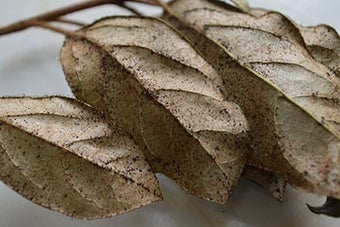
Quick facts
Common name - Gladiolus thrips
Scientific name - Thrips simplex
Plants affected - Primarily gladiolus
Main symptom - White flecks on foliage and flowers
Most active - July-September
What are gladiolus thrips?
Thrips (also known as thunder flies) are an order of insects, the Thysanoptera. Around 150 species are found in Britain. They are all small (1-2 mm long) elongate insects. Whilst many feed by sucking from leaves and flowers most do not cause noticeable damage to host plants. A few species can however cause mottling to some plants and spread plant viruses.
Gladiolus thrips are small, narrow 2 mm long, brownish-black insects that suck sap from gladiolus and some other plants including crocus, freesia, iris and lilies. There are several other species of thrips that gardeners may find casuing damge to plants, none of these affect gladioli.

Symptoms
White flecks on foliage and flowers of gladioli plants. In heaver attacks, flower petals turn brown and fail to open. Rough, grey-brown patches form on the surface of affected corms.
Management
- Tolerate the presence of some thrips damage
- When storing corms from affected plants cut down and dispose of the top growth (preferably in council ) before the is fully dried to decrease the number of overwintering thrips, reducing the likelihood of a problem in the following season
- Encourage natural enemies in gardens, for example the predatory bug Orius laevigatus can occur naturally
Download
Biological control suppliers (pdf document)
Biology
Adult gladiolus thrips are 2 mm in length, brownish-black and have narrow, elongate bodies. Adults can lay up to 100 eggs at a rate of one or two per day. These are often deposited on the younger leaves or in flower of host plants. The immature stages, nymphs, are pale yellow. There are three nymphal stages (instars).
The first two stages, like the adults, feed by sucking and are entirely wingless. ‘Wing buds’ develop on the third stage which does not feed and is known as a pre-pupal stage. The pre-pupal and pupal stages take place in the soil and in sheltered places on the host plant. Wings are not fully formed until the adult thrips emerge.
Gladiolus thrips usually has two or three generations a year but may have more during hot summers. The thrips overwinter concealed on stored corms and can even continue to reproduce as long as the temperature remains above 10°C (50°F).




